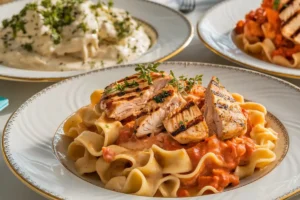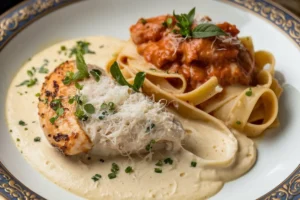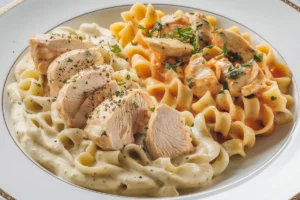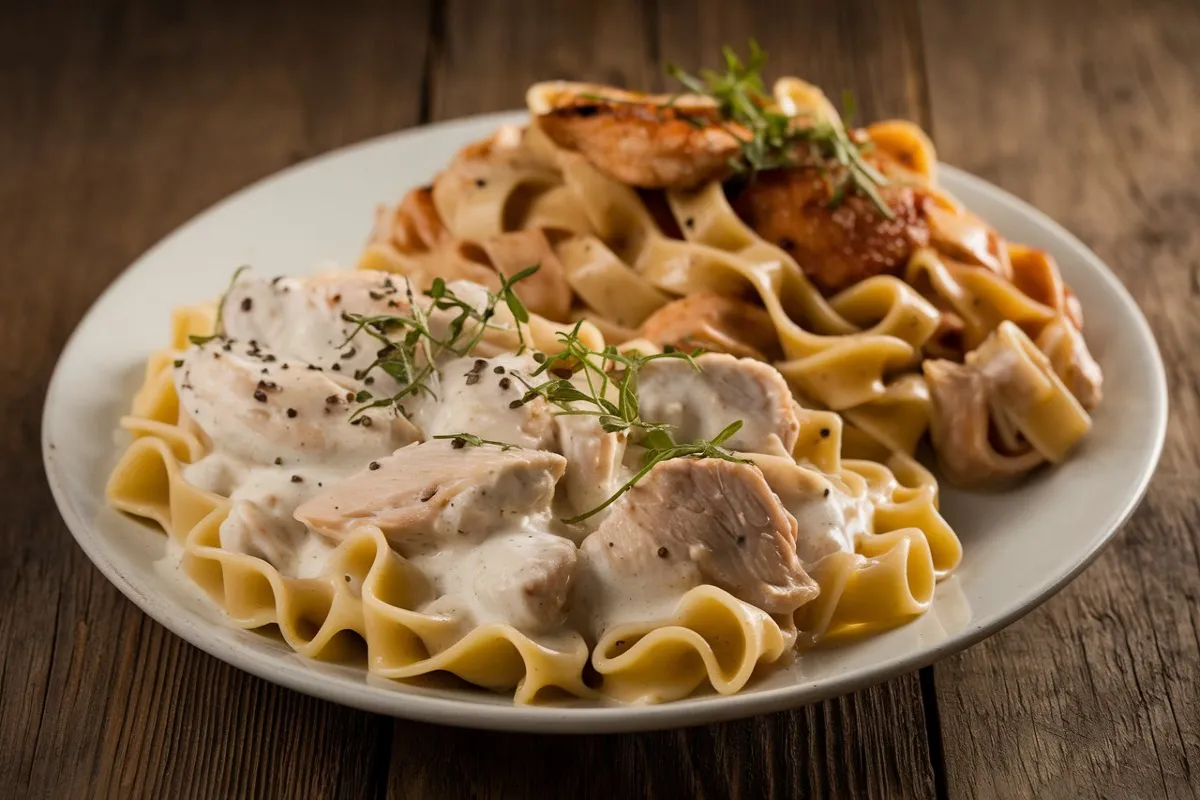Introduction to Chicken Alfredo and Chicken Fettuccine
When it comes to Italian-American cuisine, two dishes often come to mind: Chicken Alfredo and Chicken Fettuccine. These dishes are beloved for their creamy, rich flavors and satisfying textures. However, while they share some similarities, they are distinct in their ingredients, preparation, and overall culinary experience. Understanding these differences can help you choose the right dish for your next meal, whether you’re dining out or cooking at home.
Historical Background
The story of Alfredo sauce begins in Rome in the early 20th century. It was created by Alfredo di Lelio, who concocted a simple but rich sauce made from butter and Parmesan cheese. This sauce was originally served with fettuccine pasta and quickly became popular across Italy and later around the world. Today, Chicken Alfredo is synonymous with this creamy sauce, though it has evolved to include other ingredients like cream and garlic.
On the other hand, Fettuccine has deep roots in Italian cuisine. This flat, thick pasta has been a staple in Italy for centuries, traditionally served with a variety of sauces. While Alfredo sauce is one option, Chicken Fettuccine can be made with numerous other sauces, each bringing its own unique flavor to the dish.
If you’re interested in the origins of Alfredo sauce, you can dive deeper into its history by checking out the Origins of Alfredo Sauce.
Core Differences Between Chicken Alfredo and Chicken Fettuccine

Definition and Composition of Chicken Alfredo
Chicken Alfredo is a dish that centers around a rich, creamy sauce made primarily from butter, heavy cream, and Parmesan cheese. The sauce is usually served over fettuccine pasta, which is ideal for holding the thick sauce, but other types of pasta like penne or spaghetti can also be used. The key components of Chicken Alfredo include:
- Alfredo sauce: A creamy mixture of butter, heavy cream, and Parmesan cheese.
- Chicken: Typically grilled or pan-seared, adding a savory, protein-rich element to the dish.
- Pasta: While fettuccine is the traditional choice, other pasta types can be substituted depending on personal preference.
The creamy texture and rich flavor of Chicken Alfredo make it a comforting dish that’s perfect for indulgent meals.
Definition and Composition of Chicken Fettuccine
Chicken Fettuccine focuses more on the fettuccine pasta itself, which is often served with a variety of sauces. While Alfredo sauce is a popular option, Chicken Fettuccine can also be prepared with other sauces, such as:
- Garlic butter sauce: A lighter alternative to Alfredo, made with butter, garlic, and sometimes white wine.
- Pesto: A fresh, herbaceous sauce made from basil, pine nuts, garlic, Parmesan, and olive oil.
- Tomato-based sauce: A tangy, tomato-rich sauce that provides a lighter, more acidic counterpoint to the richness of Alfredo.
The versatility of Chicken Fettuccine allows for a range of flavors and textures, depending on the sauce used.
Sauce Differences
The most significant difference between Chicken Alfredo and Chicken Fettuccine lies in the sauce. Alfredo sauce is the defining feature of Chicken Alfredo, providing a creamy, rich, and slightly tangy flavor due to the Parmesan cheese. In contrast, Chicken Fettuccine is not tied to a specific sauce, allowing for a broader range of culinary expressions. This flexibility makes Chicken Fettuccine a versatile dish that can be adapted to suit different tastes and dietary needs.
For those interested in a deeper understanding of the nutritional value of Parmesan cheese, which plays a crucial role in Alfredo sauce, check out this article on the Nutritional Value of Parmesan.
Pasta Type and Cooking Techniques
Another difference between these two dishes is the pasta itself. Fettuccine is a flat, thick pasta that pairs exceptionally well with creamy sauces like Alfredo. Its shape allows it to hold the sauce effectively, ensuring every bite is flavorful. In contrast, Chicken Alfredo can be made with various types of pasta, although fettuccine remains the most traditional and popular choice.
When cooking Chicken Alfredo, the pasta is typically cooked al dente, providing a slightly firm texture that contrasts nicely with the creamy sauce. For Chicken Fettuccine, the cooking technique may vary depending on the sauce used. For example, a tomato-based sauce might call for a slightly softer pasta to better absorb the sauce’s flavors.
Nutritional Comparison
Nutritionally, Chicken Alfredo tends to be higher in calories and fat, primarily due to the richness of the Alfredo sauce. The combination of butter, heavy cream, and Parmesan cheese creates a decadent dish that is both filling and indulgent. On the other hand, Chicken Fettuccine can vary in nutritional content depending on the sauce used. A garlic butter sauce may be lighter than Alfredo, while a pesto sauce could provide a boost of healthy fats from the olive oil and nuts. A tomato-based sauce is typically the lightest option, offering lower calories and fat but higher acidity.
Culinary Variations and Recipes

Regional and Restaurant Variations
Both Chicken Alfredo and Chicken Fettuccine have inspired numerous regional and restaurant-specific variations. Here are some popular adaptations:
- Spicy Alfredo: A variation of Chicken Alfredo with the addition of red pepper flakes or chili powder to give the dish a spicy kick.
- Mushroom Alfredo: Incorporates sautéed mushrooms into the Alfredo sauce, adding an earthy flavor that complements the creamy sauce.
- Herb-Infused Fettuccine: Chicken Fettuccine with fresh herbs like basil, parsley, or rosemary, enhancing the flavor of the sauce.
- Tomato Fettuccine: Combines a tomato-based sauce with fettuccine and chicken, offering a lighter, more acidic alternative to Alfredo.
These variations highlight the versatility of both dishes, allowing cooks and chefs to experiment with flavors and ingredients to create unique takes on the classics.
Popular Recipes for Home Cooks
Cooking these dishes at home allows for endless customization. Here are two straightforward recipes that capture the essence of Chicken Alfredo and Chicken Fettuccine:
- Classic Chicken Alfredo:
- Cook fettuccine pasta until al dente, according to package instructions.
- In a large skillet, cook chicken breasts seasoned with salt and pepper until golden brown and fully cooked. Remove and set aside.
- In the same skillet, melt butter over medium heat, then add heavy cream. Bring to a simmer and reduce slightly.
- Stir in grated Parmesan cheese, whisking until the sauce is smooth and creamy.
- Add the cooked fettuccine to the skillet, tossing to coat the pasta in the sauce.
- Slice the cooked chicken and place it on top of the pasta. Serve immediately, garnished with fresh parsley.
- Traditional Chicken Fettuccine:
- Cook fettuccine pasta as directed on the package.
- Sauté chicken breasts with garlic, salt, and pepper in a large pan until fully cooked. Set aside.
- Prepare your choice of sauce (e.g., garlic butter, pesto, or tomato) in the same pan used for the chicken.
- Toss the cooked fettuccine in the sauce, ensuring the pasta is evenly coated.
- Slice the chicken and serve it over the pasta, garnished with freshly grated Parmesan or herbs.
These recipes are easily adaptable based on the ingredients you have on hand and your personal taste preferences.
Frequently Asked Questions (FAQs)
What Makes a Sauce Alfredo?
An Alfredo sauce is traditionally made with just a few simple ingredients: butter, heavy cream, and Parmesan cheese. The richness of these ingredients gives Alfredo sauce its signature creamy texture and rich flavor. While modern recipes often include garlic, pepper, and other seasonings, the essence of Alfredo sauce remains in its simplicity.
Can Fettuccine Be Used in Alfredo Dishes?
Yes, fettuccine is actually the traditional pasta used in Alfredo dishes. Its flat, thick shape is ideal for holding the creamy Alfredo sauce, making it the perfect match for Chicken Alfredo. However, other types of pasta, such as penne or spaghetti, can also be used if fettuccine is not available.
What’s Healthier: Chicken Alfredo or Chicken Fettuccine?
The healthiness of these dishes largely depends on the sauce used. Chicken Alfredo is generally higher in calories and fat due to the richness of the Alfredo sauce. In contrast, Chicken Fettuccine can be lighter if made with a different sauce, such as a tomato-based or garlic butter sauce. If you’re watching your calorie intake, opting for a lighter sauce with your fettuccine might be the better choice.
How Can I Make Chicken Alfredo More Flavorful?
To enhance the flavor of Chicken Alfredo, consider the following tips:
- Add a pinch of nutmeg to the Alfredo sauce to bring out its richness.
- Sauté garlic in the butter before adding the cream to create a deeper flavor.
- Incorporate grated Romano or Pecorino cheese alongside Parmesan for a more complex taste.
- Garnish with freshly chopped herbs like parsley or basil for a fresh finish.

Conclusion and Final Thoughts
Summary of Key Differences
In summary, while Chicken Alfredo and Chicken Fettuccine may seem similar, they are distinct dishes with unique characteristics. Chicken Alfredo is defined by its rich, creamy Alfredo sauce, which is traditionally served over fettuccine pasta. In contrast, Chicken Fettuccine highlights the use of fettuccine pasta but can be paired with a variety of sauces, allowing for more flexibility and customization.
Final Recommendations
When choosing between Chicken Alfredo and Chicken Fettuccine, consider your personal preferences and dietary needs. If you’re in the mood for something rich and indulgent, Chicken Alfredo is the way to go. However, if you prefer a dish with more flexibility in flavors, Chicken Fettuccine might be more to your liking. Both dishes offer a delicious experience, and the choice ultimately comes down to what you’re craving.
Whether you’re preparing these dishes at home or ordering them at a restaurant, understanding their differences will help you make the best choice for your meal.

